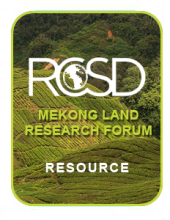Land Library
Welcome to the Land Portal Library. Explore our vast collection of open-access resources (over 74,000) including reports, journal articles, research papers, peer-reviewed publications, legal documents, videos and much more.
/ library resources
Showing items 1 through 9 of 27.Mission Statement: "The Back Pack Health Worker Team (BPHWT) is an independent, nonprofit, multi-ethnic organization dedicated to providing primary health care to ethnic groups and vulnerable populations in armed conflict and rural areas of Burma, where access to healthcare is otherwise unavailab
Over ten million people have been displaced from protected areas by conservation projects. Forced displacement in developing countries is a major obstacle to reducing poverty.
Reliable techniques for predicting N mineralisation dynamics in soil are required for sustainable management of land resources. The concept of potentially mineralisable N (N ₀) and its determination procedures were re-appraised in this study.
In Thailand's Tak province there
are 60,520 registered migrant
workers and an estimated 150,000
unregistered migrant workers from
Burma. Fleeing the social and political
problems engulfing Burma, they are
mostly employed in farming, garment
The plight of Burma's internally displaced persons has largely been overlooked by the
international community and the Burmese government itself. Villagers in the country's war
zones nevertheless have suffered for decades the adverse effects of conflict. For some,
Land policies are of fundamental importance to sustainable growth, good governance, and the well-being of, and the economic opportunities open to, both rural and urban dwellers - particularly the poor.
Nutrient-balance assessments are valuable tools for delineating the consequences of farming on soil fertility. Various approaches and methods for different situations have been used. This bulletin presents a state-of-the-art overview of nutrient-balance studies.
This report summarizes the findings of the e-mail conference that took place from 9 October to 4 November 2002 and which was organized by the Land Degradation Assessment in Drylands project (LADA).





